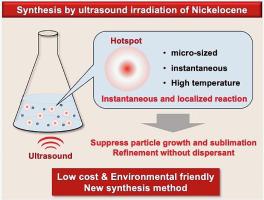当前位置:
X-MOL 学术
›
Ultrason. Sonochem.
›
论文详情
Our official English website, www.x-mol.net, welcomes your feedback! (Note: you will need to create a separate account there.)
Sonochemical decomposition effects of nickelocene aiming for low-temperature and dispersant-free synthesis of nickel fine particle
Ultrasonics Sonochemistry ( IF 8.7 ) Pub Date : 2024-06-28 , DOI: 10.1016/j.ultsonch.2024.106976 Tatsuya Shishido , Yamato Hayashi , Hirotsugu Takizawa
Ultrasonics Sonochemistry ( IF 8.7 ) Pub Date : 2024-06-28 , DOI: 10.1016/j.ultsonch.2024.106976 Tatsuya Shishido , Yamato Hayashi , Hirotsugu Takizawa

|
Sonochemical decomposition effects of nickelocene, which sublimates easily were investigated to synthesize dispersant-free nickel fine particles at low temperature. In a hydrazine monohydrate and 2-propanol mixed solvent, the reduction of nickelocene was promoted by ultrasound irradiation, and nickel fine particles were synthesized while precluding the sublimation of nickelocene. Unlike the common hydrazine reduction of nickel salts, which requires multiple-step reactions, nickelocene was reduced directly without forming intermediates. The effect of the water-bath temperature (20–60 °C) was investigated, where larger fine particles were synthesized using a higher water-bath temperature (60 °C). When irradiated at 20 °C, the reduction rate of nickelocene was low, leading to the formation of nickel fine particles and organic nanoparticles via the reduction and decomposition of nickelocene. The ultrasound frequency was also investigated, where fine nickel particles were synthesized using low-frequency ultrasound irradiation. The formation of high-temperature hotspots led to the diffusion and growth of nickel on the surface of the nickel fine particles; therefore, raspberry-like nickel fine particles were synthesized. In this study, the difficult-to-handle nature of nickelocene, owing to its sublimation properties, was easily overcome by ultrasound irradiation. Instantaneous and localized reactions at hotspots contributed to inhibiting particle growth. Furthermore, Ni fine particles were synthesized via a direct reduction pathway, which differs from previous reactions. This method represents a new, dispersant-free, low-temperature process for synthesizing Ni fine particles.
中文翻译:

二茂镍的声化学分解效应旨在低温无分散剂合成镍细粒
研究了容易升华的二茂镍的声化学分解效应,以在低温下合成无分散剂的镍细颗粒。在一水合肼和2-丙醇的混合溶剂中,通过超声波照射促进二茂镍的还原,在阻止二茂镍升华的同时合成镍微粒。与常见的镍盐肼还原需要多步反应不同,二茂镍直接还原,不形成中间体。研究了水浴温度 (20–60 °C) 的影响,使用较高的水浴温度 (60 °C) 合成了较大的细颗粒。当在20°C照射时,二茂镍的还原率较低,通过二茂镍的还原和分解,形成镍细颗粒和有机纳米颗粒。还研究了超声波频率,其中使用低频超声波照射合成了细小的镍颗粒。高温热点的形成导致镍在镍细颗粒表面扩散生长;因此,合成了覆盆子状的镍细颗粒。在这项研究中,二茂镍由于其升华特性而难以处理,但通过超声波照射很容易克服。热点处的瞬时和局部反应有助于抑制颗粒生长。此外,镍细颗粒是通过直接还原途径合成的,这与之前的反应不同。该方法代表了一种新的、无分散剂的低温合成镍细颗粒的方法。
更新日期:2024-06-28
中文翻译:

二茂镍的声化学分解效应旨在低温无分散剂合成镍细粒
研究了容易升华的二茂镍的声化学分解效应,以在低温下合成无分散剂的镍细颗粒。在一水合肼和2-丙醇的混合溶剂中,通过超声波照射促进二茂镍的还原,在阻止二茂镍升华的同时合成镍微粒。与常见的镍盐肼还原需要多步反应不同,二茂镍直接还原,不形成中间体。研究了水浴温度 (20–60 °C) 的影响,使用较高的水浴温度 (60 °C) 合成了较大的细颗粒。当在20°C照射时,二茂镍的还原率较低,通过二茂镍的还原和分解,形成镍细颗粒和有机纳米颗粒。还研究了超声波频率,其中使用低频超声波照射合成了细小的镍颗粒。高温热点的形成导致镍在镍细颗粒表面扩散生长;因此,合成了覆盆子状的镍细颗粒。在这项研究中,二茂镍由于其升华特性而难以处理,但通过超声波照射很容易克服。热点处的瞬时和局部反应有助于抑制颗粒生长。此外,镍细颗粒是通过直接还原途径合成的,这与之前的反应不同。该方法代表了一种新的、无分散剂的低温合成镍细颗粒的方法。






































 京公网安备 11010802027423号
京公网安备 11010802027423号